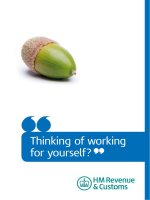presibs gclass free for you
Bạn đang xem bản rút gọn của tài liệu. Xem và tải ngay bản đầy đủ của tài liệu tại đây (492.97 KB, 29 trang )
The Business Strategy Game
Overview and Orientation
McGraw-Hill/Irwin
©2009 The McGraw-Hill Companies, All Rights Reserved
What Is The Business
Strategy Game All About?
It’s an online, PC-based exercise where you run
an athletic footwear company in head-to-head
competition against companies run by other
class members.
The marketplace is worldwide—production and
sales activities can be pursued in North
America, Latin America, Europe-Africa, and Asia
Pacific
There are 12 market segments—4 geographic
segments each for branded footwear sales to
retailers, for online footwear sales direct to
consumers, and for private-label sales
1-2
Your Company’s Situation
All companies start out on the same footing—with
equal sales volume, global market share, revenues,
profits, costs, footwear quality, and so on.
Each decision period in The Business Strategy
Game represents a year.
The company you will be running began operations
10 years ago, and the first set of decisions you and
your co-managers will make is for Year 11.
The company had Year 10 revenues of $238 million,
net profits of $25 million (equal to $2.50 per share),
an ROE of ~17%, and a solid B+ credit rating.
Your company is in sound financial condition, is
performing well, and its products are well-regarded
by the buyers of athletic footwear.
1-3
The Decisions You Will Be Making
You and your co-managers will make decisions each
period relating to
Corporate social responsibility and citizenship (up to 6
decisions)
Production of branded and private-label athletic
footwear (up to 10 decisions each plant, with a
maximum of 4 plants)
Plant capacity additions/sales/upgrades (up to 6
decisions per plant)
Worker compensation and training (3 decisions per
plant)
Shipping (up to 8 decisions each plant)
Pricing and marketing (up to 10 decisions in 4
geographic regions)
Bids to sign celebrities to endorse your company’s
footwear (2 decision entries per bid)
Financing of company operations (up to 8 decisions)
Plus there is a screen for making annual sales forecasts
and deciding whether to have inventory clearance sales
1-4
Competition Is Head-to-Head:
Company Against Company
The head-to-head competition among companies
to persuade consumers to buy their brand of
athletic footwear is based on 10 factors:
Price
Number of models/styles
Styling/quality (S/Q) rating
Advertising
Size of retailer network
Celebrity endorsements
Delivery time
Retailer support
Mail-in rebates
Shipping charges (Internet sales only)
1-5
You Have Many Strategic Options
Company managers have wide strategic latitude in
staking out a market position and striving for good
performance. There’s no built-in bias that favors any
one strategy.
Companies can pursue a competitive advantage
keyed to low-cost/low-price or top-notch footwear
features and styling or more value for the money.
Companies can have a strategy aimed at being the
clear market leader in (a) selling branded footwear to
retailers or (b) selling directly to online buyers or (c)
both.
Companies can put as little or as much emphasis on
producing private-label footwear as management
prefers.
Companies can focus on one or two geographic
regions or strive for geographic balance.
Companies can pursue essentially the same
strategy worldwide or craft slightly or very different
strategies for each geographic region.
1-6
No One Strategy Is “Best”
Most any well-conceived, well-executed
competitive approach is capable of
succeeding, provided it is not overpowered
by the strategies of competitors or defeated
by the presence of too many copycat
strategies that dilute its effectiveness.
In other words, which strategies deliver the
best performance hinges on the strength
and interplay of each company’s strategy
and decisions against the strategies and
decisions employed by rival companies—
there positively is no mystery “silver bullet”
strategy or decision combination that
players are challenged to discover.
1-7
A Company’s Competitive Effort
vis-à-vis Rivals Is Crucial
All the sales and market share differences
among companies are attributable to differing
competitive efforts on price, S/Q rating,
advertising, models offered, delivery times,
retailer support, and so forth.
Hence, every company’s strategic challenge is
to craft a competitive strategy (consisting of its
prices, S/Q ratings, advertising, models,
delivery times, retailer support, and so on) that
it believes will produce the desired sales and
market share outcomes when pitted against the
competitive strategies of rival companies,
region by region.
1-8
The Contest in the Marketplace Is a
“Battle of Strategies”
Following each year’s decisions, you’ll be
provided with Competitive Intelligence reports
containing information of the actions rivals took
to capture the sales and market shares they got.
Armed with this information, you will be in pretty
good position to figure out some of the strategic
moves that rival companies are likely to make in
the upcoming decision period.
Just as in sports where it is customary for every
team to scout its next opponent thoroughly and
develop a game plan to defeat them, you will
need to scout the strategies of rivals, try to judge
what they will do next, and come up with a
competitive strategy of your own aimed at
“defeating” their strategies and boosting your
company’s performance.
1-9
Outcompeting Rivals Is the Key
to Market Success
You’ll have to stay on top of changing market and
competitive conditions, try to avoid being
outmaneuvered and put into a competitive bind
by the actions and maneuvers of rival
companies, and make sure your footwear is
attractively priced and competitively marketed.
Just as you are trying to win business away from
rival companies, some or all rivals are certain to
be actively striving to take sales away from your
company.
It is the competitive power of your strategy vis-à-
vis the competitive power of rivals’ strategies
that is the deciding factor in determining sales
and market shares.
1-10
It’s All About Developing
Winning Strategies
The Business Strategy Game is all about
practicing and experiencing what it takes to
develop winning strategies in a globally
competitive marketplace.
When the exercise is over, the only things
separating the best-performing company
from those with weaker performances will be
the caliber of the decisions and strategies of
the management teams of the respective
companies.
It’s an exercise calculated to spur
competition and to get your competitive
juices flowing.
1-11
Some Features of the Market and
Company Environment
The industry setting in The Business Strategy
Game is modeled to closely approximate the
real-world character of the globally competitive
athletic footwear industry.
The functioning of the marketplace in The Business
Strategy Game mirrors the competitive functioning of
the real-world athletic footwear market, thus allowing
you and your co-managers to proceed rationally and
logically in deciding what to do.
Company operations are designed to be as
realistic as possible
Operations are patterned after those of an athletic
footwear company that makes its footwear at
company-operated plants.
All cause-effect relationships and revenue-cost-profit
relationships are based on sound business and
economic principles.
1-12
Some Features of the Market and
Company Environment (cont.)
The whole concept underlying The Business
Strategy Game is to put you and your comanagers in as realistic a company and
competitive market setting as possible and have
you manage all aspects of the company’s
operations
This allows you to test your ideas about how
to run a company in a competitive
marketplace
And you will be provided prompt and
detailed feedback on the outcomes of your
decisions.
1-13
PC Requirements and Mechanics
Virtually all BSG activities take place online, on a PC
that must be installed with (1) any Web browser (such
as Internet Explorer, Safari, or Firefox) and (2) the
Flash plug-in, Version 10.0 or later.
You can either use the same PC for all BSG sessions
or you can use different PCs; all that is required is an
Internet connection and any Web browser with the
Flash plug-in, Version 10.0 or later.
BSG-Online automatically transfers the needed
software from the BSG server to the PC you are
working on very quickly (within a couple of minutes
even on a slow connection); when you exit a session,
your work is saved and transferred back to the server.
The last decisions saved to the BSG server at the time of
the decision deadline are the ones used to generate
the results.
1-14
How Company Performance Is Judged
Board members and shareholders/investors have
set five performance objectives for the company:
1. Grow earnings per share at least 7% annually
2.
3.
4.
5.
through Year 15 and at least 5% annually
thereafter.
Maintain a return on equity investment (ROE) of
15% or more annually.
Maintain a B+ or higher credit rating.
Achieve stock price gains averaging about 7%
annually through Year 15 and about 5%
annually thereafter.
Achieve an “image rating” of 70 or higher (a
company’s image rating is tied to the styling/quality
of a company’s branded footwear, market share
penetration, and its actions to display corporate
citizenship and social responsibility).
1-15
Scoring Weights
The weights that will be placed on your
company’s achievement of each of the five
annual performance targets are as follows:
EPS
ROE
Credit Rating
Stock Price
Image Rating
20%
20%
20%
20%
20%
1-16
The Two Scoring Standards
Two scoring standards are used in calculating
“performance scores” for each company:
The investors expectations standard (Did
you meet or beat the annual performance
targets for each of the 5 performance
measures?)
The best-in-industry standard (How well
does your company’s performance stack up
against the company with the best EPS,
ROE, stock price, and image rating and
against an industry-best A+ credit rating?)
The scoring standards are explained in the
Player’s Guide and even more fully on the “Help”
screens for pp. 1, 2, and 3 of the Footwear Industry
Report where the company scores are reported.
1-17
The Two Quizzes
There are 2 “open book” 20 multiple-choice question
quizzes built into the exercise. The quizzes are taken
online and scored immediately upon completion:
Quiz 1: Covers the Player’s Guide—its purpose is to
spur you to read and absorb how things work in
preparation for managing your company. Time Limit
= 45 minutes.
Quiz 2: Covers the Company Reports and certain
information in the Footwear Industry Report—this
quiz serves as a check to see if you understand the
numbers and how they are calculated. Time Limit =
75 minutes.
Click on the links for the quizzes on your “Corporate
Lobby” web page for more information—the three
sample questions for each quiz give you an idea of
what to expect.
1-18
The Peer Evaluations
At the end of the exercise, you will be asked
to complete a 12-question evaluation of
each of your co-managers and a self
evaluation of your own performance.
These are completed online and can be
reviewed by clicking on the Peer Evaluation
Link on your Corporate Lobby web page.
The peer evaluations are for your instructor
only and are completely confidential.
1-19
What You Can Expect to Learn
Running the athletic footwear company in head-on competition with
rivals will give you a chance to put into play the very kinds of things you
are reading in the text about crafting and executing strategy in a globally
competitive marketplace—there is a very tight connection between the
text for the course and The Business Strategy Game.
You and your co-managers will have to chart a long-term direction for
your company, set and achieve strategic and financial objectives, craft a
strategy, and adapt it to changing industry and competitive conditions.
You’ll have to wrestle with a full array of industry statistics, company
operating reports and financial statements, and an assortment of
benchmarking data and competitive intelligence on what rivals are
doing.
You’ll have to match strategic wits with the managers of rival
companies, "think strategically" about your company's competitive
market position, and figure out the kinds of actions it will take to
outcompete rivals.
Learning to do all these things and gaining an appreciation
of why they matter are the heart and soul of courses
in business strategy.
1-20
What You Can Expect to Learn
In addition, The Business Strategy Game is designed
expressly to provide you with an experience that will:
Draw together the information and lessons of prior
courses, consolidate your knowledge about the different
aspects of running a company, and provide a capstone
experience for your business school education.
Deepen your understanding of revenue-cost-profit
relationships and build your confidence in utilizing the
information contained in company financial statements
and operating reports. You’ll see why you cannot hope to
understand a company’s business and make prudent
decisions without full command of the numbers—it won’t
take you long to appreciate why shooting from the hip is a
sure ticket for managerial disaster.
Provide you with practice in sizing up a company’s
situation, making sound, responsible business decisions,
and being accountable for delivering good results.
1-21
How Do You Register and Get Started?
The registration process consists of five steps:
Step 1: Have your assigned company registration
code handy (this code is used to put you into the
database for this specific course and to certify you as
a co-manager of your assigned industry and
company). Your instructor provides this code.
Step 2: Go to www.bsg-online.com
Step 3: Click on the “Create Student Account” button
and enter the company registration code provided by
your instructor in the box.
Step 4: Continue on to the next step of the registration
process where you will need either a credit card or a
Prepaid Access Code that came on a card bundled
with your text.
1-22
How Do You Register and Get Started?
Step 5: Complete the personal registration
information (user name, password, and so on) and
the credit card payment process (if not using the
Prepaid Access Code on the card bundled with your
textbook). The Web site for credit card payment is
fully secured; you will receive a receipt via e-mail. If
you have no credit card or Prepaid Access Code, the
easiest way to complete this step is to arrange to
use a friend’s or co-manager’s credit card and
reimburse them directly with cash or a check.
Once you are registered, you will have full use
of the student portion of the BSG Web site
and access to all of the materials and
information you will need.
1-23
The Corporate Lobby Page
Each time you log-on to www.bsg-online.com, you are
automatically routed to your company’s “Corporate Lobby” web
page.
The Corporate Lobby page is your gateway to all BSG activities.
Near the top of this page is a series of menu selections that provide
instant access to all the necessary information, materials, and tools
you will need:
The Player’s Guide
Decision Schedule
Assignments
Support
Company Name
Below these menu items are (1) a Decisions and Reports box for
accessing the decision entry screens and viewing reports, (2) a
message center box, and (3) information showing the latest
exchange rate adjustments, current interest rates, and a company
performance scoreboard.
You have anywhere, anytime access to your Corporate Lobby page
from any PC that is connected to the Internet.
1-24
Creating a Name for Your Company
Shortly after registering, you and your co-managers
should decide on a name for your athletic footwear
company.
Your company’s name must begin with the letter of
the alphabet that you have been assigned. Names
can be up to 20 characters. To name the company,
click on the Company Name menu item near the top
of the Corporate Lobby screen and enter your
company’s full name in the space provided.
All company names are “public” and appear in the
Footwear Industry Report; thus you should select a
name that you are proud of and that reflects the
image you want to project to your customers,
shareholders, other company stakeholders, and the
general public.
1-25









